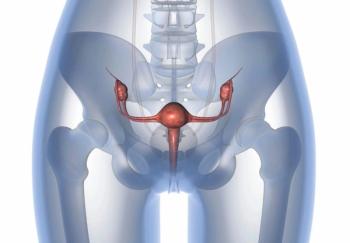
FDA Approves Ziftomenib in R/R NPM1-Mutated Acute Myeloid Leukemia
Clinical data from the phase 1b/2 KOMET-001 trial support the agency’s approval of ziftomenib in this patient population.
The News
The FDA has approved ziftomenib (Komzifti) as a treatment for patients with relapsed/refractory NPM1-mutated acute myeloid leukemia (AML), according to a press release from the agency.1
Supporting Data
The agency’s decision was supported by findings from the
Previously, data were presented at the
Efficacy data from a pooled analysis in the trial revealed that the median overall survival (OS) among patients treated with the investigational therapy at 600 mg daily (n = 112) was 6.1 months (95% CI, 3.8-8.4), with responders exhibiting a median OS of 16.4 months (95% CI, 9.6-20.4) vs 3.5 months (95% CI, 2.5-4.0) among those without a response. Furthermore, minimal residual disease (MRD)–negativity was attained in 65% of patients treated with the agent.
The complete response (CR) or CR with partial hematologic recovery (CRh) rate for this population was 25%, with 7% and 18% achieving a CRh and CR, respectively. The overall response rate (ORR) was 35%, with 4% of patients experiencing a CR with incomplete hematologic recovery (CRi) or CR with incomplete platelet recovery (CRp); 5% of patients experiencing a morphologic leukemia-free state (MLFS); and 1% of patients experiencing a partial response (PR).
The median duration of response (DOR) was 3.7 months (95% CI, 1.9-7.7) among those who attained a CR/CRh; 5.1 months (95% CI, 2.8-8.1) among those who experienced a composite CR (CRc); and 4.6 months (95% CI, 3.6-7.7) among all responders. Furthermore, comparable CR/CRh rates were observed across pre-specified subgroups, including those with receipt of prior hematopoietic stem cell transplantation (HSCT) or venetoclax (Venclexta), and those with the presence of FLT3/IDH co-mutations.
KOMET-001 Trial Design
In the phase 2 portion of the trial, the primary end point was the CR/CRh rate among patients treated with 600 mg of daily ziftomenib. Key secondary end points encompassed DOR, MRD negativity, transfusion independence, and adverse effects (AEs). Initially, patients with NPM1-mutatedand KMT2A-rearranged disease, among other subtypes, were treated with escalating doses of ziftomenib starting at 50 mg daily up to 1000 mg daily in a phase 1a dose-escalation cohort.
In a phase 1b dose-validation cohort, patients with NPM1-mutatedand KMT2A-rearranged disease were dosed with the 2 potential R2PDs—200 mg and 600 mg daily—with a phase 1b expansion cohort consisting of patients with NPM1-mutated disease treated with 600 mg daily. The phase 2 registration-enabling portion of the trial included the same patient subpopulation and dose level as the 1b dose-expansion cohort. Across the phase 1b and phase 2 cohorts, patients were enrolled from January 26, 2023, to May 13, 2024.
The phase 1b portion of the trial consisted of 20 patients with relapsed/refractory NPM1-mutated AML, all 20 of whom discontinued treatment at data cutoff. In the phase 2 portion of the trial, 92 patients were enrolled, 83 of whom discontinued treatment, with 9 receiving ongoing therapy at data cut off. The most common reasons for dose discontinuation included disease progression (n = 34), AEs (n = 17), lack of efficacy (n = 12), study withdrawal (n = 8), and death (n = 3).
Patients in the pooled phase 1b/2 population had a median age of 69 years (range, 22-86), with 63% of patients being at least 65 years of age. A total of 56% of patients were women, 79% were White, and 51% vs 49% were based in the United States or Canada vs Europe. Most patients had an ECOG performance status of 1 (56%) and FLT3-ITD co-mutational status (42%).
Furthermore, this population had a median bone marrow aspirate blast percentage of 44.0% (range, 0.5%-98%) and 2 prior therapies (range, 1-7), and there was a broadly even split between patients treated with 1 (33%), 2 (33%), or 3 or more (34%) prior therapies. Prior HSCT, venetoclax, and menin inhibition were received in 23%, 60%, and 1% of patients, respectively.
Safety Data
In the pooled analysis, any-grade or grade 3 or higher treatment-emergent AEs (TEAEs) occurred in 100% and 94% of patients, respectively. The most common grade 3 or higher hematologic TEAEs included febrile neutropenia (22%), anemia (21%), and thrombocytopenia (20%). The most common grade 3 nonhematologic AEs included pneumonia (15%), differentiation syndrome (13%), hypokalemia (12%), and diarrhea (4%).
Of note, there were low rates of ziftomenib-related myelosuppression, and no clinically significant QTc prolongation occurred, with only 3% of patients experiencing events. Even though differentiation syndrome occurred in grade 3 severity in 13% of patients, no grade 4 or 5 events were observed.
Any-grade and grade 3 or higher treatment-related AEs (TRAEs) occurred in 69% vs 40% of patients, respectively. The most common grade 3 or higher hematologic TRAEs included anemia (5%) and neutropenia (5%). The most common nonhematologic grade 3 or higher TRAE was differentiation syndrome (13%). A total of 3% of dose discontinuations were attributable to TRAEs.
The FDA previously
References
- FDA approves ziftomenib for relapsed or refractory acute myeloid leukemia with a NPM1 mutation. News release. FDA. November 13, 2025. Accessed November 13, 2025. https://tinyurl.com/2mcsxzuv
- Wang ES, Montesinos P, Issa GC, et al. Ziftomenib in relapsed/refractory (R/R) NPM1-mutant acute myeloid leukemia (AML): phase 1b/2 clinical activity and safety results from the pivotal KOMET-001 study. J Clin Oncol. 2025;43(suppl_16):6506. doi:10.1200/JCO.2025.43.16_suppl.6506
- Kura Oncology and Kyowa Kirin announce FDA acceptance and priority review of new drug application for ziftomenib in adults with relapsed or refractory NPM1-mutant AML. News release. Kura Oncology, Inc, Kyowa Kirin Co. June 2, 2025. Accessed September 10, 2025. https://tinyurl.com/yca5675t
- Kura Oncology receives breakthrough therapy designation for ziftomenib in NPM1-mutant AML. News release. Kura Oncology, Inc. April 22, 2024. Accessed September 10, 2025. https://tinyurl.com/muzr3bye
Newsletter
Stay up to date on recent advances in the multidisciplinary approach to cancer.






















































































